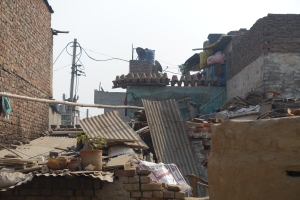Today as I visited a “bargaining” market, Sarojini, here in New Delhi, I got to see just how starkly different the white woman is treated from the Indian woman. It is common knowledge that an expat is going to be price gouged in many ways and it is often called the “white man’s tax.” Today, a couple of down to earth Indian women got to see first hand the experience.
In our church, I am involved in the women’s organization, the Relief Society, and I work closely with three other women in planning for our meetings and looking after the women in our organization. One woman is getting married and the four of us thought it would be a very kind gesture to buy a wedding gift for the bride from the Relief Society organization. Knowing the limited resources that these other three women have, I offered to purchase the gift if I could get some direction on what to buy. Clothing for the bride was the unanimous suggestion, which really put me at a loss, as I knew I was the wrong woman of the four of us to be making that decision. So we made it a group effort and we headed to the market together.

One of the women with me in the stall bargaining.
Before meeting this morning, one of the women called me to let me know it would probably be best if the Indian women did the bargaining. I have lived in India long enough to have understood that reasoning. As we got out of the car at the market, I let them know that I would just stand to the side as they looked and bargained. Well, the first stall we approached, I was evidently not standing far enough away from the rest of them as the shopkeeper gave them a very overpriced amount for the item. I caught on real quick that I was not helping here. So for the rest of the time as we walked the market, I sauntered well behind and did not go near the stall when they looked at the items. Once the items had been chosen and bargained for, I entered the stall with them. These wonderful women got to see a little of my world as street vendors haggled me as we walked down the road and high prices were sent my way, but for me it was just another day in Delhi.
When Tyler and I had some culture training after arriving in India, we learned that in India there is a belief that if one can take advantage of someone, they should. Honesty does not even cross most of their minds. One of our drivers has told us that 90% of the drivers in New Delhi are dishonest. It can be the siphoning of gas off your car or returning the receipt with prices a little higher than expected as they added a little something on for themselves. This mindset is prevalent from the neighbors deciding its okay to connect their electricity to your lines so that they don’t have to pay their own bill to the taxi or auto rickshaw driver announcing that the meter is broken when they see me coming. Honesty is truly a virtue and what a day it was at the market to see just how starkly different the price is for me versus a normal Indian woman.














